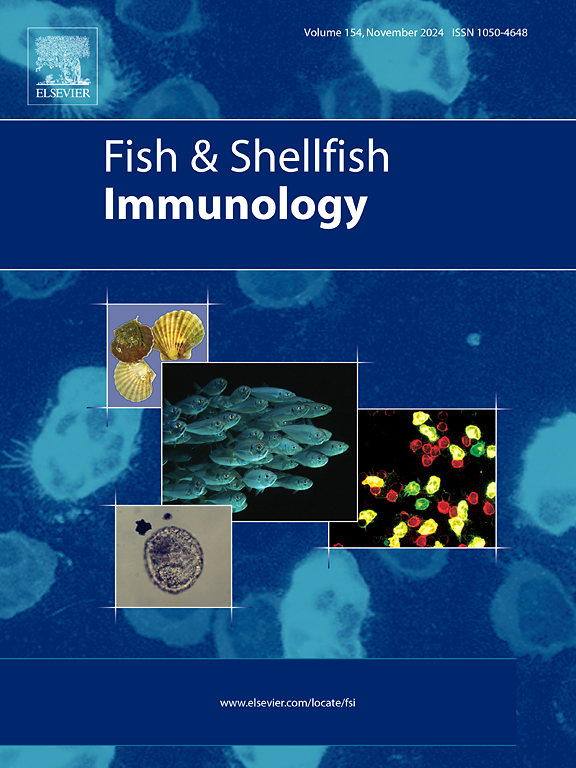Identification and characterization of 16 tripartite motif-containing proteins from Takifugu obscurus
IF 4.1
2区 农林科学
Q1 FISHERIES
引用次数: 0
Abstract
Tripartite motif-containing (TRIM) proteins play important roles in apoptosis, development, autophagy, and innate immunity in vertebrates. In this study, a total of 16 TRIM genes were cloned and identified from obscure puffer Takifugu obscurus. Multiple alignment results showed that most of the deduced ToTRIM proteins contained three typical motifs, a really interesting new gene (RING) zinc-finger domain, one B-box, and a coiled-coil domain, which together formed the TRIM motif found in this large family of proteins. The carboxyl terminus of ToTRIMs is architecturally unique, with frequent examples being the ADP ribosylation factor-like domain, the B30.2 (PRY-SPRY) domain, the fibronectin type III domain, and the pleckstrin homology domain. Phylogenetic analysis revealed that 16 ToTRIMs were evolutionarily closely related to their counterparts in other selected vertebrates. Tissue distribution analysis showed that the mRNA transcripts of most ToTRIM genes were constitutively expressed in all tissues examined, with relatively high expression in immune tissues. After infection with Vibrio harveyi, the expression levels of 16 ToTRIM genes in the kidney and liver were significantly upregulated, and their responses over time varied. Taken together, our results suggested that ToTRIM genes are involved in the antibacterial immune responses of T. obscurus, which is expected to provide new insights into the functional characteristics of TRIMs in teleost fish.
鉴定和表征来自鳞栉泷鱼的 16 种含三方图案的蛋白质。
含三方基序蛋白(TRIM)在脊椎动物的凋亡、发育、自噬和先天免疫中发挥着重要作用。本研究克隆并鉴定了暗纹河豚的16个TRIM基因。多重比对结果显示,大多数推导出的ToTRIM蛋白包含三个典型的基序、一个真正有趣的新基因(RING)锌指结构域、一个B-box和一个线圈结构域,它们共同构成了这个蛋白大家族中的TRIM基序。ToTRIMs的羧基末端结构独特,常见的有ADP核糖基化因子样(ARF)结构域、B30.2(PRY-SPRY)结构域、纤连蛋白III型结构域(FN3)和Pleckstrin同源结构域(PHD)。系统进化分析表明,16 个 ToTRIMs 在进化上与其他选定脊椎动物中的对应物密切相关。组织分布分析表明,大多数ToTRIM基因的mRNA转录本在所有受检组织中均为组成型表达,在免疫组织中的表达量相对较高。感染哈维弧菌后,16 个 ToTRIM 基因在肾脏和肝脏中的表达水平显著上调,且随时间的变化而变化。综上所述,我们的研究结果表明,ToTRIM基因参与了遮目鱼的抗菌免疫反应,这有望为了解TRIMs在远洋鱼类中的功能特性提供新的视角。
本文章由计算机程序翻译,如有差异,请以英文原文为准。
求助全文
约1分钟内获得全文
求助全文
来源期刊

Fish & shellfish immunology
农林科学-海洋与淡水生物学
CiteScore
7.50
自引率
19.10%
发文量
750
审稿时长
68 days
期刊介绍:
Fish and Shellfish Immunology rapidly publishes high-quality, peer-refereed contributions in the expanding fields of fish and shellfish immunology. It presents studies on the basic mechanisms of both the specific and non-specific defense systems, the cells, tissues, and humoral factors involved, their dependence on environmental and intrinsic factors, response to pathogens, response to vaccination, and applied studies on the development of specific vaccines for use in the aquaculture industry.
 求助内容:
求助内容: 应助结果提醒方式:
应助结果提醒方式:


